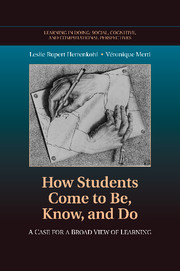Book contents
- Frontmatter
- Contents
- Series Foreword
- Acknowledgments
- How Students Come to Be, Know, and Do
- Introduction
- 1 The Context Lens
- 2 How Ways of Knowing, Doing, and Being Emerged in the Classroom: Interpersonal Interactions and the Creation of Community, Part I
- 3 How Ways of Knowing, Doing, and Being Emerged in the Classroom: Interpersonal Interactions and the Creation of Community, Part II
- 4 Personal Lens of Analysis: Individual Learning Trajectories
- Conclusion
- References
- Index
- Titles in the series
1 - The Context Lens
Published online by Cambridge University Press: 06 December 2010
- Frontmatter
- Contents
- Series Foreword
- Acknowledgments
- How Students Come to Be, Know, and Do
- Introduction
- 1 The Context Lens
- 2 How Ways of Knowing, Doing, and Being Emerged in the Classroom: Interpersonal Interactions and the Creation of Community, Part I
- 3 How Ways of Knowing, Doing, and Being Emerged in the Classroom: Interpersonal Interactions and the Creation of Community, Part II
- 4 Personal Lens of Analysis: Individual Learning Trajectories
- Conclusion
- References
- Index
- Titles in the series
Summary
The analyses that we discuss in this book are part of a study that was designed to encourage students to think scientifically using explicitly defined social roles and intellectual practices. This chapter provides important background information about the context of the data collection, including demographic information on the school and the study participants. Information about the genesis of the study, its purpose, and its central guiding principles are provided. Classroom-based materials and practices are described. Key analytical questions for the contextual plane are: What are the major physical, social, and demographic characteristics of the institutional context and where is it situated? What are the most important values, principles, practices, and tools for knowing and doing in this context? What range of emotions is expected within the classroom context? What values or distinctions of worth exist to guide conduct within the institutional context?
The School
Data collection took place in a public science and technology magnet school situated in the poorest quadrant of a New England city. Approximately 800 children attended the school, making it (at the time of data collection) the largest public elementary school in New England. As a neighborhood magnet school, it welcomed children who lived in the neighborhood and attracted students from throughout the city as part of a voluntary de-isolation plan. A rich racial, ethnic, and socioeconomic mix of students resulted. In 35 classrooms from preschool through grade 6, about half of the student population was children of color.
- Type
- Chapter
- Information
- How Students Come to Be, Know, and DoA Case for a Broad View of Learning, pp. 27 - 44Publisher: Cambridge University PressPrint publication year: 2010



